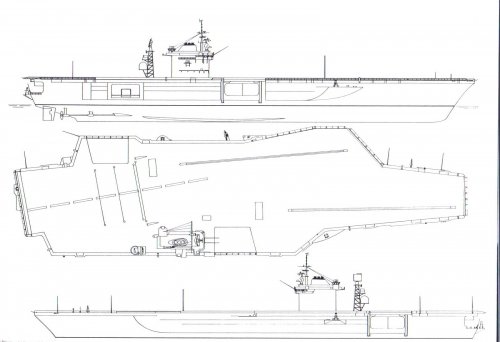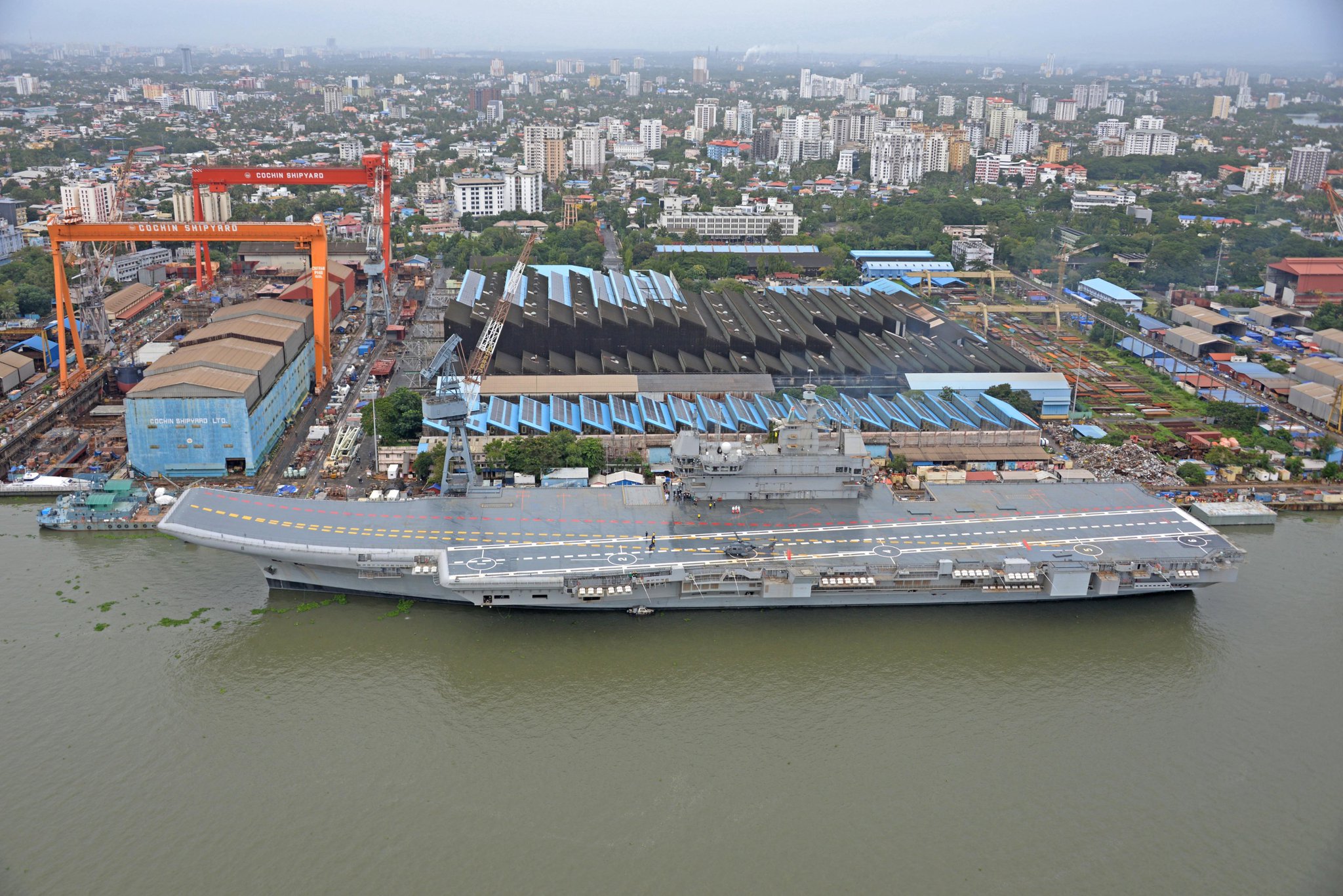Indian Ministry of Defense press release
(slightly edited by me for the forum)
Image via Cochin Shipyard Ltd (CSL)
Showcasing the country’s growing prowess of indigenous manufacturing and a major milestone in the path towards
‘Aatmanirbhar Bharat’ (Self-reliant India) Prime Minister Narendra Modi commissioned the country’s first indigenous aircraft carrier Indian Naval Ship (INS) Vikrant at Cochin Shipyard Limited (CSL) on September 02, 2022.
During the event, the Prime Minister also unveiled the new Naval Ensign (Nishaan), doing away with the colonial past and befitting the rich Indian maritime heritage. He dedicated the new ensign to 17th century Maratha ruler Chhatrapati Shivaji, the builder of one of the world's most formidable naval fleets of the time.
Addressing the gathering, the Prime Minister said, here on the coast of Kerala, every Indian is witnessing the sunrise of a new future. This event being held on the INS Vikrant is a tribute to the rising spirits of India on the world horizon. He said that today we are seeing a manifestation of the dream of the freedom fighters where they envisioned a capable and strong India.
The modified St. George's Cross has been replaced with an Ensign symbolizing the Octagonal seal of the founder of the Maratha Empire, Chatrapathi Shivaji
Vikrant is huge, massive, and vast. Vikrant is distinguished, Vikrant is also special. Vikrant is not just a warship. This is a testament to the hard work, talent, influence and commitment of India in the 21st century. If the goals are distant, the journeys are long, the ocean and the challenges are endless – then India’s answer is Vikrant. The incomparable Amrit of Azadi ka Amrit Mahotsav is Vikrant. Vikrant is a unique reflection of India becoming self-reliant.
- Narendra Modi, Indian Prime Minister
Commenting on the new mood of the nation, the Prime Minister said, no challenge is too difficult for today’s India. He said “today, India has joined those countries in the world, which manufacture such a huge aircraft carrier with indigenous technology. Today INS Vikrant has filled the country with a new confidence, and has created a new confidence in the country.” The Prime Minister acknowledged and praised the contribution of the Navy, engineers of Cochin Shipyard, scientists and specially the workers who worked on the project. He also noted the happy and auspicious occasion of Onam that is adding even more happiness to the occasion.
Every part of INS Vikrant has its own merits, a strength, a development journey of its own. It is a symbol of indigenous potential, indigenous resources and indigenous skills. The steel installed in its airbase is also indigenous, developed by DRDO scientists and produced by Indian companies, he said. Explaining the massive proportions of the Carrier, the Prime Minister said it is like a floating city. It produces electricity that is sufficient to power 5000 households and the wiring used will reach Kashi from Kochi, he said. He said that INS Vikrant is a living embodiment of the Spirit of the Panch Prans that he proclaimed from the ramparts of Red Fort.
The Prime Minister talked about the Indian Maritime tradition and naval capabilities. Chhatrapati Veer Shivaji Maharaj, he said, built such a navy on the strength of this sea power, which kept the enemies on their toes. When the British came to India, they used to be intimidated by the power of Indian ships and trade through them. So they decided to break the back of India’s maritime power. History is witness to how strict restrictions were imposed on Indian ships and merchants by enacting a law in the British Parliament at that time, the Prime Minister said.
The Prime Minister remarked that when Vikrant descends to protect our maritime zone, many women soldiers of the Navy will also be stationed there. Now the Indian Navy has decided to open all its branches for women. The restrictions that were there are now being removed. Just as there are no boundaries for the capable waves, there will be no boundaries or restrictions for the daughters of India.
Commenting on the changing geo-strategic situation, he said in the past, security concerns in the Indo-Pacific region and the Indian Ocean have long been ignored. But, today this area is a major defence priority of the country for us. That is why we are working in every direction, from increasing the budget for the Navy to increasing its capability, he said. The Prime Minister said that a strong India will pave the way for a peaceful and safe world.
In his address, Defence Minister Rajnath Singh termed the commissioning of INS Vikrant at the onset of ‘Amritkal’ as a testament to the Government’s strong resolve to ensure the safety and security of the nation in the next 25 years.
INS Vikrant is a glowing symbol of an aspirational and self-reliant ‘New India’. It is an icon of pride, power and resolve of the Nation. Its commissioning is an unprecedented achievement in the path of building indigenous warships. Indian Navy’s tradition is ‘old ships never die’. This new avatar of Vikrant, which played a stellar role in the 1971 war, is a humble tribute to our freedom fighters and brave soldiers.
- Rajnath Singh, Indian Defence Minister
Rajnath Singh also asserted that it is a key responsibility of the Indian Navy to secure the country’s maritime interests for uninterrupted maritime trade, amid the constantly-changing global situation. He commended the Navy for always being the ‘First Responder’ in times of any national or international crisis and exuded confidence that the commissioning of INS Vikrant will further enhance the force’s capability.
He added that this is an assurance to the friendly foreign countries that India is fully capable of meeting the collective security needs of the region. “We believe in a free, open and inclusive Indo-Pacific. Our efforts in this regard are guided by ‘SAGAR’ (Security and Growth for All in the Region) as envisioned by the Prime Minister,” he said.
Rajnath Singh listed a series of steps taken by the Ministry of Defence to achieve the objective. These include setting up of defense corridors in Uttar Pradesh and Tamil Nadu; issuance of three positive indigenization lists; earmarking of 68% of capital procurement budget for domestic industry; Defence Production and Export Promotion Policy 2020 and increase in FDI limit. He said, the aim is ‘Make in India, Make for the World’, and exports of more than $400 billion in the last year is a proof of this vision.
Speaking on the occasion, Chief of the Naval Staff Admiral R Hari Kumar voiced the Navy’s resolve for India@100 to become completely self-reliant by 2047, consisting of ‘Made in India’ ships, submarines, aircraft, unmanned vessels and systems and remain a ‘Combat Ready, Credible, Cohesive and Future-Proof Force’. He added that the Navy is determined to move forward on the path of five pledges – developed India, removing any sign of servility, pride in heritage, unity and fulfilling the duties – as envisioned by the Prime Minister.
The Chief of the Naval Staff exhorted the Commanding Officer and crew of INS Vikrant to take forward the proud legacy of erstwhile Vikrant which served the country for 36 glorious years and played a significant role in the 1971 war.
Vikrant meaning victorious and gallant, the foundation for prestigious IAC (Indigenous Aircraft Carrier) was firmly established in April 2005 by ceremonial Steel Cutting. In order to push the indigenization drive, the Warship grade steel required for the construction of IAC was successfully indigenized through the Steel Authority of India Limited (SAIL) in collaboration with the Defence Research and Development Laboratory (DRDL) and the Indian Navy. The hull fabrication progressed thereafter and the ship’s keel was laid in February 2009. The first phase of ship construction was completed with the successful launch of the ship in August 2013.
The readiness of the ship’s propulsion and Power generation equipment/systems in the harbor was tested as part of Basin Trials on Nov 20.
Vikrant has completed multiple phases of Sea Trials from August 2021 to date, where the ship’s performance, including the response of the ship’s hull to various conditions of operations, maneuvering trials, main propulsion, Power Generation, and Distribution (PGD), ship’s Navigation and Communication systems, endurance testing of propulsion machinery, and so on.
The 262 m long and 62 m wide Vikrant displaces approx 43,000 T when fully loaded, having a maximum designed speed of 28 Knots with an endurance of 7500 NM. The ship has around 2200 compartments, designed for a crew of around 1600 that include specialized cabins to accommodate women officers and sailors. The carrier is designed with a very high degree of automation for machinery operations, ship navigation, and survivability.
The ship would be capable of operating an air wing consisting of 30 aircraft comprising of MiG-29K fighter jets, Kamov-31, MH-60R multi-role helicopters, in addition to indigenously manufactured Advanced Light Helicopters (ALH) and Light Combat Aircraft (LCA) (Navy). Using a novel aircraft-operation mode known as Short Take-Off But Arrested Recovery (STOBAR), the IAC is equipped with a ski-jump for launching aircraft, and a set of three ‘arrester wires’ for their recovery onboard.
The ship boasts of a full-fledged Medical Complex with the latest medical equipment facilities that include major modular OT, emergency modular OT, physiotherapy clinic, ICU, laboratories, CT scanner, X-Ray machines, Dental complex, Isolation ward, telemedicine facilities, etc.
Specifications of Vikrant:
- Length: 262.5 m
- Width: 61.6 m
- Height (Keel to pole mast): 61.6 m
- Displacement: appx 42.800 tonnes
- Speed (Max/Cruise): 28/18 knots
- Flight Deck area: 12.500 SqM
- Propulsion: GTs – 22MWx4, DAs – 3MWx8
- Range: 7500 Nautical Miles
- Weapons: SAM – 32xMRSAM, AK630 CIWS
- Air Wing: Mix of 30 Aircraft & Helicopters
- Runway: Landing – 191m, Long Take-off – 203m, Short Take-off – 145m
- Helo landing spots: 6
- 3 x Arresting Gear Wires
- 2 x SAC lifts (10×14 m)
India commissioned the first indigenous aircraft carrier, INS Vikrant, with a ceremony held in Cochin Shipyard on 02 September 2022.

www.navalnews.com
@Nilgiri @Cabatli_TR @MisterLike @Yasar @Anmdt @AlphaMike @Milspec @Ryder @Test7 and everyone else









